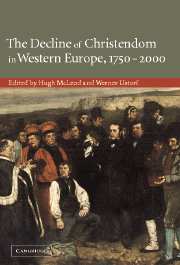Book contents
- Frontmatter
- Contents
- List of contributors
- Preface
- 1 Introduction
- Part I
- 2 The secularisation decade: what the 1960s have done to the study of religious history
- 3 Christendom in decline: the Swedish case
- 4 New Christianity, indifference and diffused spirituality
- Part II
- Part III
- Part IV
- Index of people and places
- Subject index
2 - The secularisation decade: what the 1960s have done to the study of religious history
Published online by Cambridge University Press: 03 July 2009
- Frontmatter
- Contents
- List of contributors
- Preface
- 1 Introduction
- Part I
- 2 The secularisation decade: what the 1960s have done to the study of religious history
- 3 Christendom in decline: the Swedish case
- 4 New Christianity, indifference and diffused spirituality
- Part II
- Part III
- Part IV
- Index of people and places
- Subject index
Summary
Introduction
I start this chapter with a series of presumptions about the state of existing knowledge in the social history of religion. (1) Britain in the 1960s experienced more secularisation than in all the preceding four centuries put together. Never before had all of the numerical indicators of popular religiosity fallen simultaneously, and never before had their declension been so steep. (2) It is clear now at the start of the twenty-first century that what commenced in the 1960s was a statistically secular (i.e. permanent) change, and not a cyclical (or temporary) one. There is currently no evidence, nor theory of human behaviour (outside of faith itself), that posits that recovery in those numerical indicators will ever take place. (3) Statistical evidence previously used to identify what was once supposed to be secularisation during previous periods of history (notably in the eighteenth, nineteenth and early twentieth centuries) can now be seen in a new context as showing nothing more than relatively minor, ambiguous, often contradictory, and short-term religious change which was, in any event, neither statistically fool-proof evidence even on its own terms, nor sufficiently broad in its coverage of what religiosity is as to offer a safe conclusion.
What happened in the late twentieth century has been unique and epoch-forming. Since around 1963, Britain has been in the brave new world of secular secularisation – that is, the permanent decline of religion. This decline takes two main observable forms.
- Type
- Chapter
- Information
- The Decline of Christendom in Western Europe, 1750–2000 , pp. 29 - 46Publisher: Cambridge University PressPrint publication year: 2003
- 16
- Cited by

